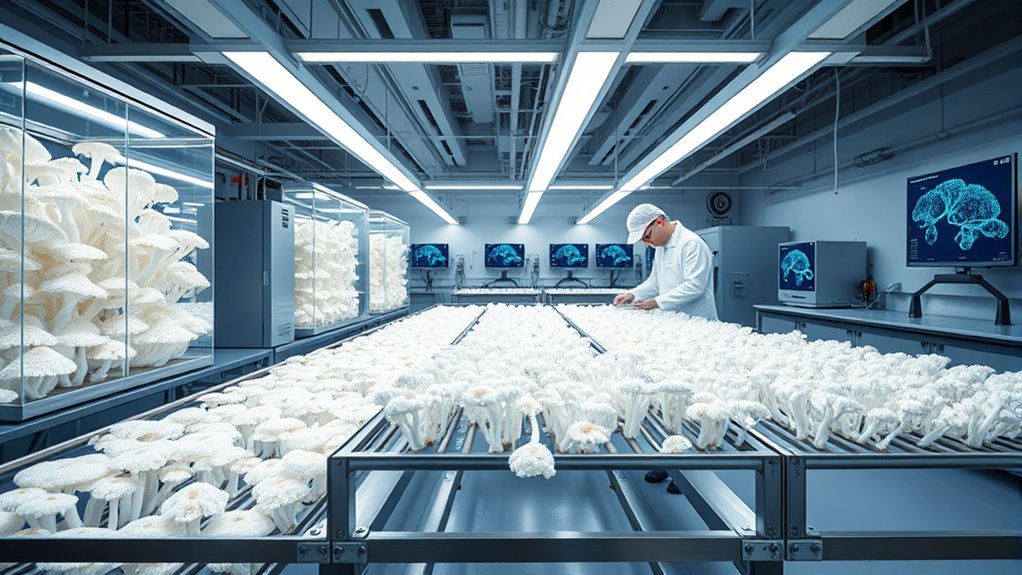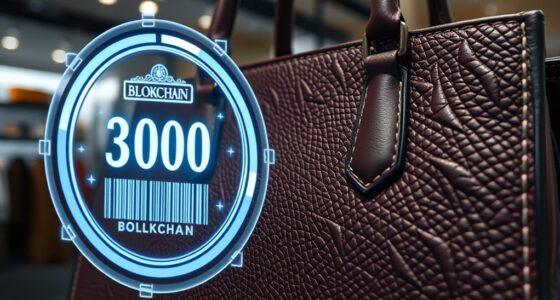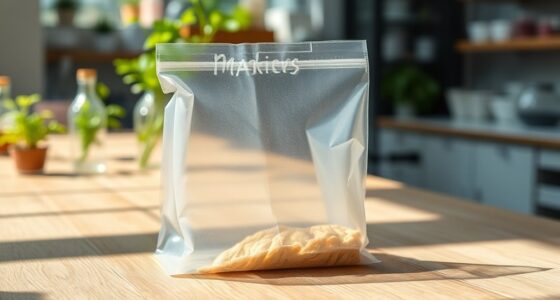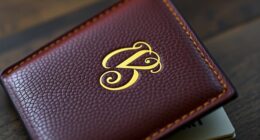Recent lab advancements are making mushroom leather more durable, flexible, and scalable. Breakthroughs in cultivation techniques use genetic engineering and optimized growth conditions to produce high-quality material efficiently. Innovations in coatings, fibers, and finishing processes improve durability, colorfastness, and texture. These developments also focus on reducing environmental impact through waste reduction and sustainable practices. If you want to discover how these strides are shaping its future in fashion and industry, there’s more to explore ahead.
Key Takeaways
- Advances in genetic engineering and environmental controls are enabling scalable, efficient lab cultivation of high-quality mushroom leather.
- Innovative finishing techniques enhance durability, flexibility, and colorfastness, making mushroom leather more competitive in mainstream markets.
- Sustainable practices like waste reduction, recycling, and energy-efficient processes are reducing environmental impact during production.
- Ongoing research and remote hackathons foster collaboration, accelerating improvements in material properties and production methods.
- Growing industry interest and consumer demand position mushroom leather as a stylish, eco-friendly alternative across fashion and automotive sectors.
Breakthroughs in Mycelium Cultivation Techniques
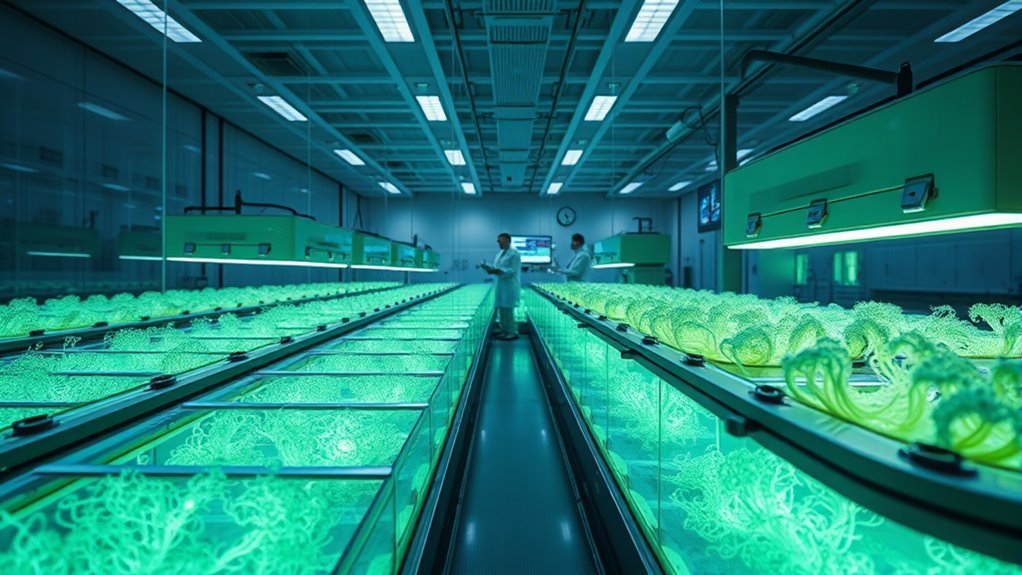
Recent advances in mycelium cultivation techniques are transforming how we produce mushroom leather. Researchers are now leveraging mycelium genetic engineering to customize the cellular structure, enhancing the material’s properties. By manipulating the fungi’s genetic makeup, scientists can promote desirable traits like faster growth and stronger fibers. Fungal growth optimization has also played a pivotal role, allowing for more efficient and scalable production processes. Techniques such as controlled environmental conditions and precise nutrient management accelerate mycelium development while maintaining quality. These innovations make it possible to produce higher-quality mushroom leather with fewer resources and less time. Additionally, remote hackathons have become a valuable platform for researchers and developers to collaborate on sustainable material science projects, accelerating innovation in this field. As a result, the industry moves closer to sustainable, customizable alternatives to traditional leather, opening new opportunities for eco-friendly fashion and material science.
Enhancements in Durability and Flexibility
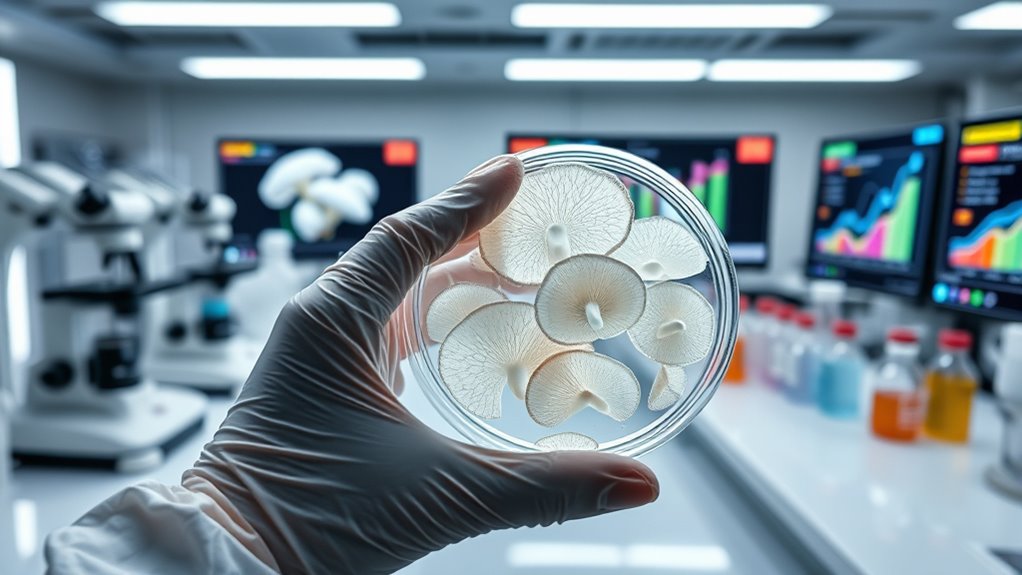
Advancements in processing methods are considerably boosting the durability and flexibility of mushroom leather. These improvements help it compete with synthetic alternatives, increasing consumer acceptance. Techniques like cross-linking mycelium fibers and applying innovative bonding agents strengthen the material’s resilience. Here are key developments:
- Enhanced Fiber Structure: Reinforcing the fiber matrix improves tear resistance and longevity.
- Flexible Coatings: Applying stretchable, eco-friendly coatings maintains suppleness during use.
- Optimized Tanning Processes: New tanning methods reduce stiffness, making mushroom leather more adaptable.
These innovations directly address concerns about durability and flexibility, making mushroom leather a more viable, sustainable alternative to synthetic options. As consumer acceptance grows, these enhancements will likely accelerate the adoption of mushroom-based materials in various industries.
Innovations in Coloration and Finishing Processes
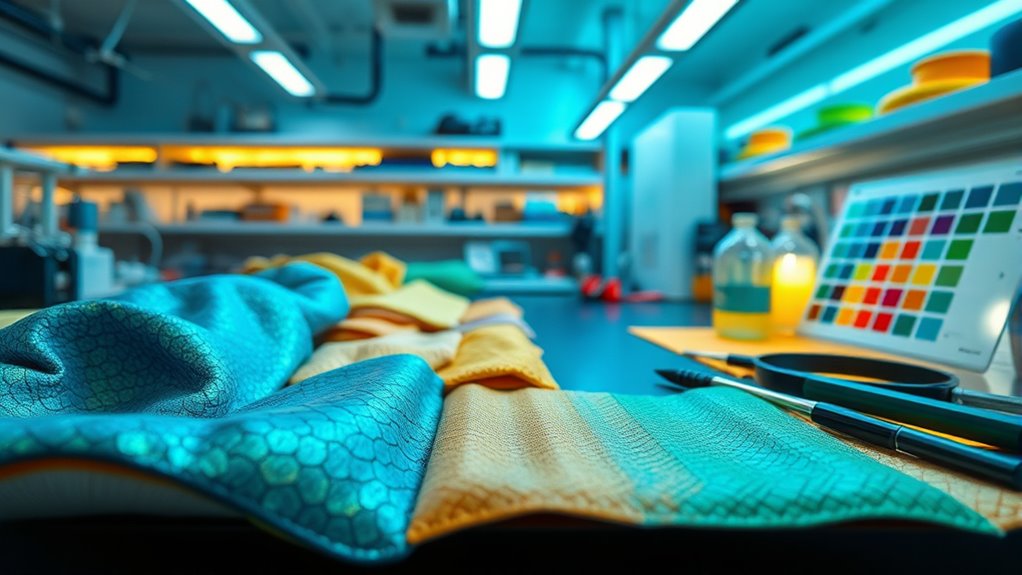
Innovations in coloration and finishing processes are transforming mushroom leather into a more versatile and visually appealing material. New dyes and finishes focus on eco-friendly solutions that address biodegradability challenges, making the material more sustainable. Techniques like water-based dyes and plant-based finishes reduce chemical use and environmental impact, helping mushroom leather meet eco-conscious standards. These advancements also aim to boost consumer acceptance by offering vibrant, durable colors without sacrificing sustainability. By improving colorfastness and texture, manufacturers create products that appeal to both fashion trends and environmental values. The role of color accuracy in enhancing visual appeal is increasingly recognized in the development of new finishing techniques. As these innovations continue, mushroom leather will become more competitive with traditional materials, offering a sustainable alternative that’s customizable and visually striking. This progress ensures mushroom leather’s growing role in eco-friendly fashion and design.
Scaling Up Production: From Lab to Industry
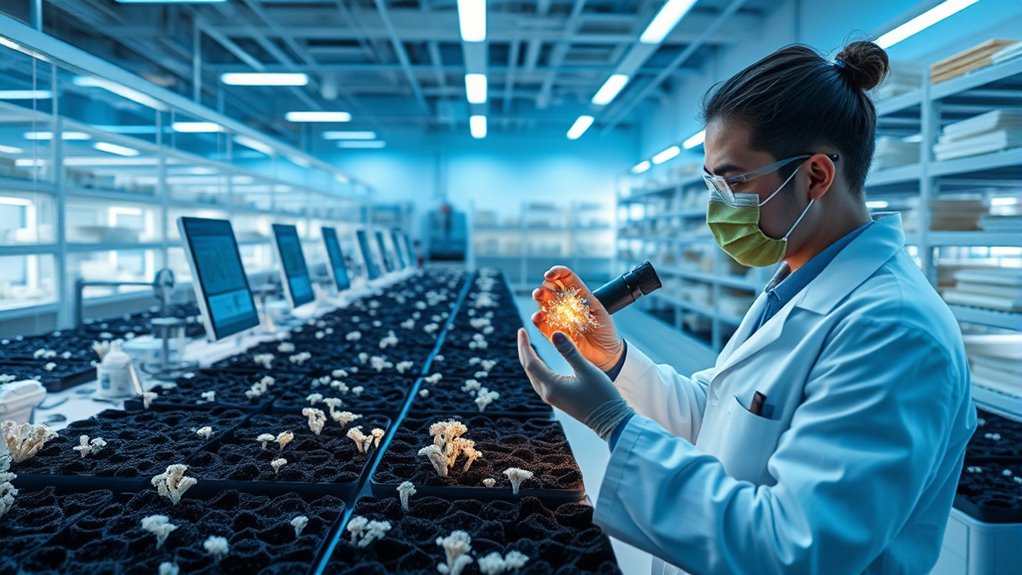
Turning mushroom leather from a promising concept into a viable industry product requires overcoming several production challenges. First, scaling the cultivation process must guarantee consistent quality, especially for high-demand applications like automotive seating and fashion accessories. Second, developing cost-effective manufacturing methods is essential to compete with traditional materials. Third, establishing supply chains for raw materials and distribution channels will facilitate industry adoption. Another consideration is understanding retirement tax implications, which, while not directly related to production, can influence long-term financial planning for industry stakeholders. By addressing these issues, you can help transform mushroom leather from a niche innovation into a mainstream alternative. Achieving this scale will open doors for its use in luxury fashion accessories and eco-friendly automotive interiors. Streamlining production without sacrificing quality is key to meeting market demands and advancing sustainable material solutions.
Environmental Impact and Sustainability Metrics
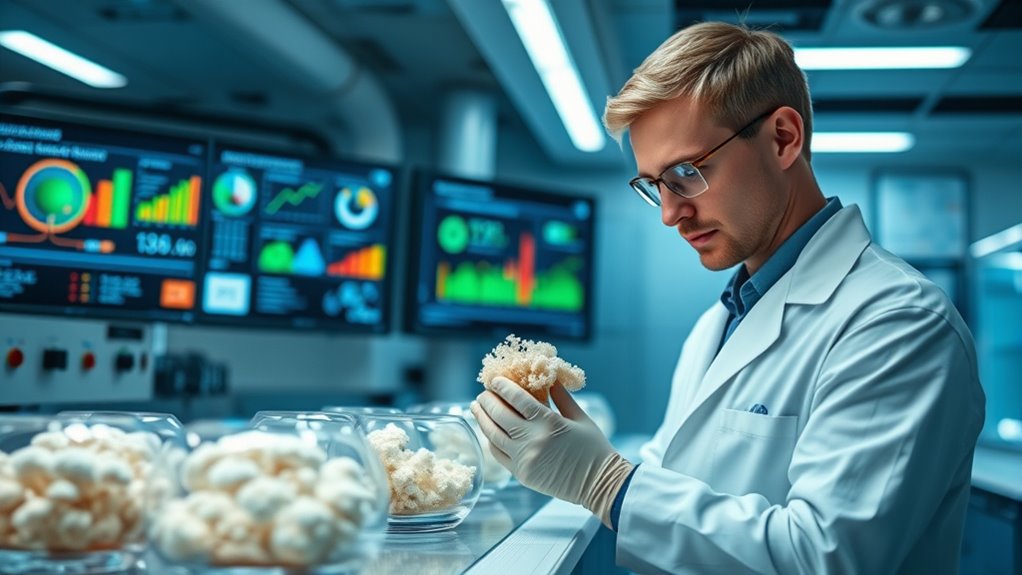
You can reduce the environmental impact of mushroom leather by lowering its carbon footprint through efficient production methods. Using renewable materials benefits both the planet and your sustainability goals, making the process more eco-friendly. Additionally, waste minimization strategies help guarantee fewer byproducts end up in landfills, maximizing resource use. Incorporating sustainable investment strategies into the development process can further enhance the overall environmental benefits.
Carbon Footprint Reduction
How much can mushroom leather truly reduce environmental impact compared to traditional materials? Quite a bit, actually. Its lower energy requirements during production mean a smaller carbon footprint. Additionally, mushroom leather offers biodegradability benefits, helping reduce waste in landfills. To maximize its sustainability, focus on these key factors:
- Production Efficiency: Uses less water and energy, lowering greenhouse gas emissions.
- Biodegradability Benefits: Breaks down naturally, decreasing long-term waste.
- Consumer Acceptance: Grows as awareness of eco-friendly options increases, encouraging wider adoption.
- Raw Material Sourcing: Utilizing locally available mushroom substrates can further reduce environmental impacts associated with transportation.
These factors collectively boost mushroom leather’s potential to cut down overall environmental impact while appealing to eco-conscious consumers. The combination of reduced carbon footprint and biodegradability benefits makes it a promising alternative to traditional leather, aligning with sustainability goals.
Renewable Material Benefits
Because mushroom leather is derived from renewable fungal biomass, it considerably enhances sustainability metrics compared to synthetic or animal-based materials. Its biodegradability means it can break down naturally, making it an excellent option for eco-friendly products like biodegradable packaging. This reduces landfill waste and minimizes environmental pollution. Additionally, mushroom leather supports vegan fashion by providing a cruelty-free alternative that doesn’t involve animal harm or exploitation. Its renewable nature guarantees a smaller carbon footprint over its lifecycle, contributing to a more sustainable supply chain. By choosing mushroom leather, you help promote responsible consumption and reduce reliance on non-renewable resources, aligning with eco-conscious values. Moreover, understanding the aura influence of sustainable materials can inspire consumers to make more environmentally conscious choices. Overall, its environmental benefits make mushroom leather a compelling choice for those committed to sustainability and ethical fashion.
Waste Minimization Strategies
Implementing waste minimization strategies in mushroom leather production considerably boosts its environmental sustainability. By adopting effective waste reduction methods, you can lower the ecological footprint and enhance resource efficiency. Recycling initiatives play a crucial role in minimizing waste, transforming by-products into useful materials or compost. To optimize these efforts, consider these key strategies:
- Implement recycling initiatives to repurpose leftover substrate and scraps.
- Use waste reduction methods during manufacturing to prevent excess material generation.
- Develop closed-loop systems that reuse water and process by-products, reducing overall waste.
- Incorporate the Law of Attraction principles by fostering a mindset focused on sustainability and positive environmental impact, encouraging innovative waste reduction solutions.
These approaches not only decrease environmental impact but also improve sustainability metrics, making mushroom leather a more eco-friendly alternative to traditional materials. Your commitment to waste minimization directly supports a greener future and the growth of sustainable fashion.
Future Applications and Market Potential

What makes mushroom leather an exciting prospect is its versatility and eco-friendly nature, which open up numerous market opportunities. As fashion trends shift towards sustainable materials, mushroom leather aligns perfectly with consumer acceptance of eco-conscious products. You can see its potential in footwear, accessories, and even upholstery, offering stylish alternatives without harming the environment. Brands are increasingly keen to incorporate innovative, sustainable materials, giving mushroom leather a competitive edge. Its durability and unique texture appeal to designers seeking fresh, eco-friendly options. As awareness grows, the market for mushroom leather will expand, driven by consumers who prioritize sustainability and quality. Additionally, ongoing research and development in lab-based cultivation techniques are expected to improve production efficiency and material properties. Overall, the future of mushroom leather looks promising, with significant growth potential across various industries committed to reducing their ecological footprint.
Frequently Asked Questions
How Does Mushroom Leather Compare Cost-Wise to Traditional Leather?
You might wonder about the cost comparison between mushroom leather and traditional leather. Generally, mushroom leather can be more affordable because its production expenses are lower, thanks to simpler processes and faster growth cycles. While initial investment might be comparable, ongoing costs tend to be less for mushroom leather, making it an attractive sustainable alternative. As demand grows, prices could further decrease, benefiting your budget and eco-conscious choices.
Are There Any Health Concerns Associated With Mushroom Leather Production?
Did you know that some mushroom toxins can pose health risks? When producing mushroom leather, you should be aware of allergen risks and potential mushroom toxins, though most lab processes minimize these concerns through careful sterilization. While generally safe, it is crucial to stay informed about possible allergic reactions. Overall, mushroom leather is a sustainable alternative, and with proper handling, health concerns remain minimal for consumers.
What Are the Current Regulatory Challenges for Commercializing Mushroom Leather?
You face regulatory hurdles and complex certification processes when commercializing mushroom leather. Managing different regional standards can be challenging, as authorities often lack specific guidelines for this innovative material. You need to guarantee your product meets safety, environmental, and quality standards, which can slow down market entry. Staying informed about evolving regulations and working closely with certifying bodies helps you overcome these hurdles and successfully bring your mushroom leather products to consumers.
Can Mushroom Leather Be Recycled or Biodegraded Easily?
You might wonder if mushroom leather can be recycled or biodegraded easily. It’s promising because a biodegradability assessment shows it breaks down faster than traditional leather, reducing environmental impact. Recycling processes are still developing, but they’re becoming more efficient, allowing you to reuse mushroom leather. Overall, it offers a sustainable alternative, and advances in recycling and biodegradation make it an increasingly eco-friendly choice for your needs.
How Soon Will Mushroom Leather Be Widely Available in Mainstream Markets?
While it’s tempting to think mushroom leather might soon be everywhere, market adoption takes time. You’ll likely notice consumer perception gradually shifting as people become more aware of its eco-friendly benefits. Though some brands are already experimenting, widespread availability in mainstream markets could still be a few years away. Patience and continued innovation are key, as these factors will shape how quickly mushroom leather becomes a common choice for consumers like you.
Conclusion
As you step into the future of mushroom leather, imagine it as a vibrant forest coming to life—each breakthrough a new leaf unfolding, vibrant and full of promise. With innovations shaping durability, color, and sustainability, this eco-friendly material is set to transform industries, like a gentle breeze moving through treetops. Embrace this evolution, where nature’s ingenuity meets human innovation, creating a greener, more flexible world just waiting for you to explore.
